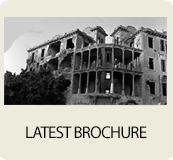
|
|
|
Built in 1924 by the Lebanese architect Youssef Afandi Aftimos and then raised by two further floors by the architect Fouad Kozah in 1932, the neo-ottoman style building known as the "Yellow House" or the "Barakat Building" stands on the crossroad of Damascus street and Independence street. The name of the Yellow House comes from the ochre-coloured sandstone used for its construction. The Yellow House comprises two bourgeois style houses, four-stories high plus a roof terrace. The central axis of the building is completely open to the sky. It leads to the main entrance and a front courtyard giving access to the staircases up to the properties and a passageway under the building that leads to the leafy rear courtyard. The facades of the two buildings are joined by raised columns, decorated with fine ironwork, which overlook the city. Located on the former "green line", the Yellow House was a forward control post and sniper base during the civil war. In addition to its strategic location, the airy architecture of the Yellow House, with its transparency and varied shooting angles, was used for military purposes to control the surrounding area, known as the "Sodeco Crossroads". Today, this building is therefore an unusual structure due to this combination of domestic architecture and "war architecture", created by the snipers that occupied the building during the civil war. |
Construction work to start soon
Under the auspices of the President of the City Council, Mr Bilal Hamad, two managers have been appointed to run the Beit Beirut project, namely Mr Nadim Abourizk, Vice-President of the Council and Mr Rachid Achkar, City Councilor. Thanks to the efforts of this new team, the project advanced considerably in 2011, most notably being granted the required construction permit. The forthcoming short-term targets include choosing both the construction company and the cultural service provider responsible for bringing the concept chosen for Beit Beirut to life. Both parties will be working in coordination with the Scientific Committee.
Click here to see the latest brochure


NOBRAND
